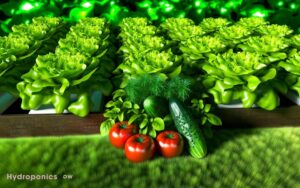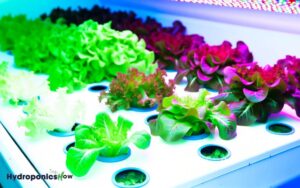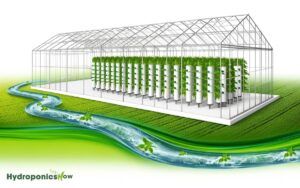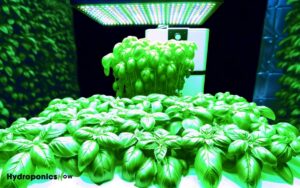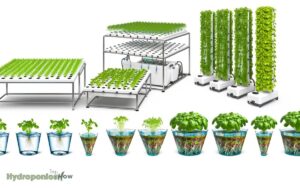What Type of Soil for Hydroponic? Optimal Mediums!
In hydroponics, ‘soil’ is replaced with various growing media to support plant roots. Key options include Rockwool, coconut coir, perlite, vermiculite, and expanded clay pellets.
Each medium has unique properties:
- Rockwool offers superior water retention and stable pH;
- Coconut coir provides a near-neutral pH and sustainable use;
- Perlite delivers excellent drainage and aeration;
- Vermiculite excels in water retention and nutrient holding; and
- Clay pellets guarantee ideal aeration.
Selecting the right medium depends on factors such as water retention, pH stability, and crop requirements. To better understand which medium best suits your hydroponic system, explore more about each option.
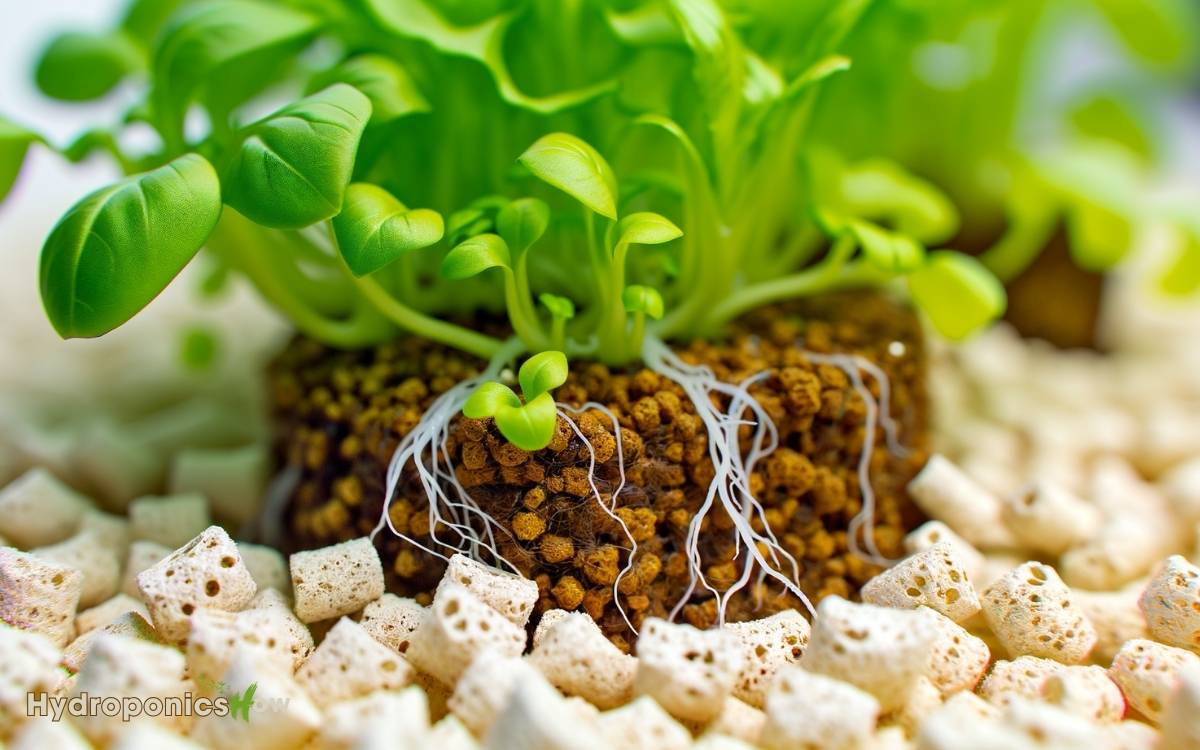
Key Takeaways
Understanding Growing Media
Understanding the various types of growing media is fundamental to maximizing plant health and productivity in hydroponic systems.
Growing media, also known as substrates, provide essential support and aeration for plant roots, facilitating nutrient uptake and water retention.
Key hydroponic substrates include Rockwool, perlite, vermiculite, and expanded clay pellets. Each medium has unique properties:
Rockwool offers excellent water retention and aeration, while perlite and vermiculite enhance soil structure and drainage. Expanded clay pellets, popular for their inert nature, provide stability and reusability.
Selecting the appropriate substrate involves considering factors such as water-holding capacity, pH neutrality, and root support.
By understanding these properties, growers can tailor their media choices to meet specific crop requirements and environmental conditions, ensuring peak plant health.
Coconut Coir
Coconut coir, derived from the fibrous husks of coconuts, serves as an effective and sustainable hydroponic growing medium due to its excellent water retention, aeration, and natural resistance to pathogens.
This medium consists of three main components: coir pith, fibers, and chips, each contributing distinct properties. Coir pith excels in moisture retention, while fibers enhance aeration and structural stability.
Additionally, coconut coir offers a near-neutral pH, facilitating ideal nutrient uptake. Its lignin content supports microbial life, promoting root health. However, it is important to pre-buffer coir with calcium nitrate to counteract its high potassium and sodium levels.
Ultimately, coconut coir provides a balanced, eco-friendly medium, conducive to robust plant growth in hydroponic systems.
Perlite
Perlite, a naturally occurring volcanic glass, is extensively utilized in hydroponic systems due to its superior drainage properties and inert nature.
Its unique physical structure, characterized by a high porosity and lightweight form, facilitates ideal aeration and prevents waterlogging, thereby promoting robust root development.
Chemically inert, perlite does not alter the nutrient solution’s pH, ensuring a stable growing environment. Additionally, its sterile nature minimizes the risk of pathogen contamination, a critical factor for maintaining plant health.
Despite its apparent advantages, it is essential to integrate perlite with other media to balance moisture retention and aeration.
This combination enhances plant growth by providing a balanced microenvironment conducive to nutrient uptake and root respiration.
Vermiculite
Vermiculite, a hydrous phyllosilicate mineral, is highly valued in hydroponic systems for its exceptional water retention and cation-exchange properties.
This mineral expands upon heating, resulting in a lightweight, porous structure that can hold substantial amounts of water and nutrients.
Its high cation-exchange capacity (CEC) facilitates nutrient availability to plant roots, ensuring efficient uptake of essential minerals.
Additionally, vermiculite‘s neutral pH and inert nature make it suitable for a variety of hydroponic applications. It also provides aeration, preventing root suffocation while maintaining necessary moisture levels.
However, care must be taken to avoid over-saturation, which can lead to root rot in some hydroponic setups. Properly balanced, vermiculite can greatly enhance plant growth and productivity in hydroponic systems.
Rockwool
Rockwool, composed of spun volcanic rock fibers, excels in hydroponic systems due to its superior water retention properties, enabling consistent moisture availability for plant roots.
Its stable pH levels reduce the need for frequent pH adjustments, thereby simplifying nutrient management.
These characteristics make Rockwool an ideal medium for precision-controlled hydroponic cultivation.
Water Retention Properties
Renowned for its excellent water retention properties, Rockwool serves as a highly efficient substrate in hydroponic systems, ensuring ideal moisture availability for plant roots.
This medium is composed of spun molten rock fibers, creating a highly porous structure that can retain significant quantities of water while also providing adequate aeration.
The capillary action within Rockwool facilitates uniform water distribution, ensuring that roots receive consistent hydration.
Its high water-holding capacity minimizes the frequency of irrigation, contributing to the stability of the hydroponic environment. Moreover, Rockwool’s inert nature prevents nutrient interactions, maintaining the integrity of the nutrient solution.
These characteristics make Rockwool an exceptional choice for optimizing water retention and overall plant health in hydroponic cultivation systems.
Ph Stability
In addition to its impressive water retention properties, Rockwool also exhibits remarkable pH stability, a critical factor for maintaining ideal nutrient availability and preventing root stress in hydroponic systems.
Rockwool’s pH neutrality guarantees that it does not alter the pH of the nutrient solution, facilitating the best uptake of essential minerals.
This attribute minimizes the need for frequent pH adjustments, thereby improving system efficiency and reducing labor.
| Factor | Impact on Hydroponics |
|---|---|
| pH Stability | Maintains nutrient availability |
| Reduced pH Fluctuations | Prevents root stress |
| Minimal Adjustments | Enhances operational efficiency |
| pH Neutrality | Ensures consistent nutrient absorption |
| System Compatibility | Suitable for various hydroponic setups |
Rockwool’s stable pH characteristic is thus essential for cultivating robust and healthy plants in hydroponic environments.
Clay Pellets
Clay pellets, also known as expanded clay aggregate or hydroton, are a widely utilized growing medium in hydroponic systems due to their excellent aeration properties and neutral pH.
These pellets, formed by heating clay to high temperatures, create a porous structure ideal for root oxygenation and water retention.
Advantages include:
- Optimal Aeration: Guarantees roots receive adequate oxygen, enhancing plant growth.
- Neutral pH: Maintains stable nutrient uptake without altering water chemistry.
- Reusable: Can be sterilized and reused, promoting sustainability.
- Inert Material: Does not introduce pathogens or contaminants into the system.
- Moderate Water Retention: Balances moisture levels, reducing the risk of overwatering.
Peat Moss
Peat moss, a highly absorbent organic material derived from decomposed sphagnum moss, is frequently employed in hydroponic systems for its superior moisture retention and nutrient-holding capacity.
This substrate’s fibrous structure enhances capillary action, ensuring uniform distribution of water and nutrients to plant roots.
Rich in humic substances, peat moss offers a slightly acidic pH, which can be beneficial for certain crops. However, its natural acidity may necessitate pH adjustments using lime or other alkaline agents.
Additionally, peat moss is lightweight and easy to handle, making it a practical choice for various hydroponic setups.
Despite its benefits, sustainability concerns arise due to the slow regeneration rate of peat bogs, urging consideration of alternative or supplemental substrates.
Sand
Sand, with its excellent drainage and aeration properties, proves beneficial in hydroponic systems by preventing waterlogging and ensuring root oxygenation.
However, its low nutrient retention capacity necessitates frequent nutrient solution adjustments to sustain peak plant growth.
Additionally, sand’s ease of sterilization and inherent cleanliness make it a practical choice for maintaining a pathogen-free environment.
Drainage and Aeration Benefits
Ideal drainage and aeration are pivotal for hydroponic systems, and sand’s granular structure offers an effective medium for achieving these essential conditions.
The large particle size and inert nature of sand facilitate efficient water movement and air exchange, preventing root rot and promoting healthy growth.
Sand’s ability to maintain an ideal balance of moisture and oxygen is essential for root respiration and nutrient uptake.
- Prevents waterlogging: Sand promotes rapid water drainage, reducing the risk of root suffocation.
- Enhances root oxygenation: The porous nature allows adequate air flow, essential for root health.
- Reduces pathogen proliferation: Good aeration minimizes the conditions favorable for pathogenic growth.
- Supports robust root development: Consistent moisture levels aid in stronger root systems.
- Ensures uniform water distribution: Sand’s texture helps in even water dispersion, preventing dry spots.
Nutrient Retention Challenges
While sand offers significant advantages with regards to drainage and aeration, it presents notable challenges in nutrient retention due to its low cation exchange capacity (CEC).
The CEC measures a substrate’s ability to hold and exchange positively charged ions (cations) like potassium, calcium, and magnesium.
Sand, with its coarse texture and large particle size, provides limited surface area for cation adsorption, resulting in rapid nutrient leaching. This necessitates frequent nutrient solution applications to sustain plant health, increasing operational complexity.
Additionally, sand’s poor nutrient retention can lead to inconsistent nutrient availability, potentially stressing hydroponic plants.
To mitigate these issues, sand-based systems often incorporate supplementary materials like organic matter or synthetic amendments to enhance nutrient-holding capacity.
Sterilization and Cleanliness
Maintaining sterilization and cleanliness in sand-based hydroponic systems is essential to prevent pathogen buildup and promote peak plant health.
Sand, while effective in supporting plant roots, can harbor harmful microorganisms if not properly sanitized. Utilizing sterilization techniques such as heat treatment or chemical disinfectants can mitigate this risk.
Regular monitoring and maintenance are critical to guarantee continued system efficacy.
- Pathogen Control: Prevent diseases that can devastate crops.
- Optimal Growth: Promote vigorous plant development.
- System Longevity: Extend the lifespan of hydroponic setups.
- Nutrient Efficiency: Ensure nutrient solutions remain uncontaminated.
- Peace of Mind: Cultivate confidence in system reliability.
Gravel
Gravel, known for its excellent drainage properties, is a commonly utilized inert medium in hydroponic systems to support root aeration and nutrient delivery.
Composed primarily of small, irregularly shaped stones, gravel facilitates ideal oxygen penetration and prevents water stagnation, thereby avoiding root rot.
Its high porosity ensures efficient water flow, while its weight provides stability to the plant structure. Due to its inert nature, gravel does not alter the pH or nutrient composition of the hydroponic solution, making it a reliable medium for various plant types.
However, it requires regular washing to remove accumulated salts and debris, guaranteeing prolonged efficacy. The practicality of gravel lies in its reusability and minimal maintenance, making it a cost-effective choice for hydroponic cultivators.
Oasis Cubes
Oasis Cubes, a popular hydroponic medium composed of phenolic foam, offer superior moisture retention and uniform aeration, making them an excellent choice for seed germination and young plant propagation.
These cubes provide a stable environment for roots, enhancing nutrient uptake efficiency. Their pH neutrality guarantees minimal chemical interaction, fostering ideal growth conditions. Additionally, their lightweight structure simplifies handling and transplanting processes.
Key benefits include:
- Consistent Moisture Levels: Guarantees hydration without waterlogging.
- Uniform Aeration: Promotes healthy root development and oxygen availability.
- pH Neutrality: Minimizes pH adjustments, reducing labor.
- Ease of Use: Simplifies seedling transplantation and system integration.
- Sterility: Reduces risk of pathogens, ensuring healthier plant growth.
These attributes make Oasis Cubes indispensable in precision hydroponic cultivation.
Conclusion
In hydroponic systems, the choice of growing media is akin to selecting the foundation for a skyscraper; it determines the stability and success of plant growth. The growing media must provide adequate support, aeration, and moisture retention to ensure optimal root development. Different materials, such as coconut coir, perlite, and rock wool, offer unique benefits depending on the plants being cultivated. Additionally, understanding factors like nutrient absorption and how to choose grow lights can further enhance plant health and productivity in hydroponic systems.
Coconut coir, perlite, vermiculite, rockwool, peat moss, sand, gravel, and oasis cubes each offer unique physicochemical properties that cater to various horticultural needs.
Understanding the characteristics and applications of these substrates allows for optimized nutrient delivery and root aeration, ensuring robust plant development and maximizing agricultural productivity.


